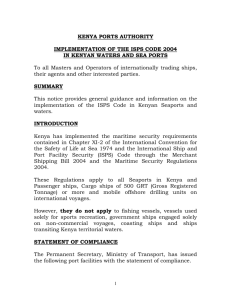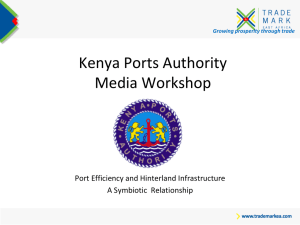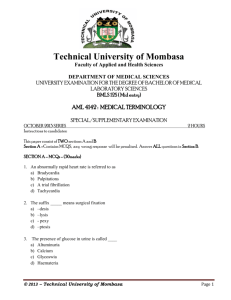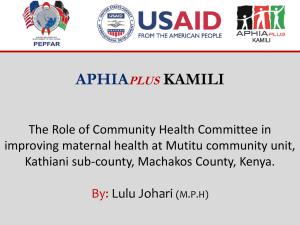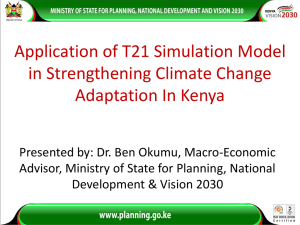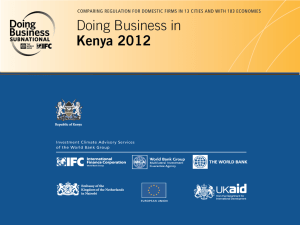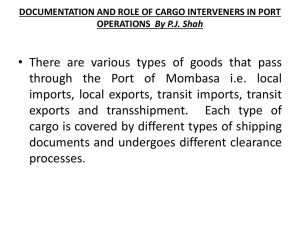Kenya Economic Update Launch Presentation
advertisement
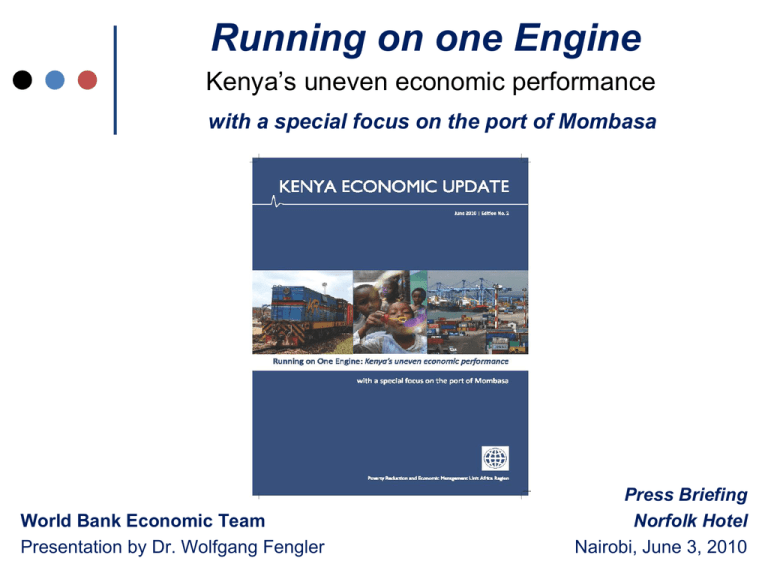
Running on one Engine
Kenya’s uneven economic performance
with a special focus on the port of Mombasa
World Bank Economic Team
Presentation by Dr. Wolfgang Fengler
Press Briefing
Norfolk Hotel
Nairobi, June 3, 2010
Main messages
• Kenya is recovering - slowly but surely. For 2010, the World Bank is
revising its growth forecast upwards to 4.0 percent. For 2011, we project
4.9 percent, if no shocks occur.
• However, Kenya is running on one engine. Over the last decade
growth has been imbalanced, predominantly driven by domestic
consumption fuelled by imports. Exports have been weak and non-tradable
sectors, such as services and construction have performed strongly.
• The Infrastructure deficit constrains exports and the port of
Mombasa is still under-performing. Despite some improvements, port
reforms have not kept up with the momentum in other African countries. It
still takes 20 days to bring a container from Mombasa to Nairobi. This is
longer than to ship the same container from Singapore to Mombasa.
Recent Economic Developments
and Outlook for 2010
Kenya’s economy is recovering – slowly
but surely…
Economic Outlook
8
7
6
5
Percent
4
3
2
1
0
-1
2007
2008
2009
2010
2011
-2
GDP Kenya
GDP SSA
Percapita Kenya
Percapita SSA
…but lags behind growth in East Africa
8
Economic Growth 2009
6
GDP growth %
4
2
0
-2
-4
Ethopia
Uganda
Tanzania
Rwanda
Ghana
Kenya
SSA average South Africa
Services have been the drivers of growth
in 2009, agriculture contracted again
10.0
Sectoral Growth Rate
8.0
6.0
Percent
4.0
2.0
(2.0)
(4.0)
(6.0)
2007
agriculture (25.5)
2008
industry (18.8)
2009
services (55.7)
… and Kenya’s ICT revolution continues:
20 mn phone connections; 4 mn internet connections
Telephone and Internet Connections
21
Internet users ('000)
4,000
20
3,800
19
3,600
18
17
3,400
16
3,200
15
3,000
14
2,800
13
Q2
Q3
2008
Internet users ('000)
Q4
Q1
Q2
Q3
2009
Telephone connections (millions)
Q4
Telephone connections (millions)
4,200
Macroeconomic management has been strong:
Inflation and interest rates declined sharply since 2008
25
9.0
Inflation
91 day T.bills rate
8.5
8.0
20
7.5
7.0
15
6.5
6.0
10
5.5
5.0
5
4.5
Jan
March
May
July
Sept.
Nov.
Jan
March
May
July
Sept.
Nov.
Jan
March
May
2008
2009
2010
Jan
March
May
July
Sept.
Nov.
Jan
March
May
July
Sept.
Nov.
Jan
March
4.0
0
2008
2009
2010
Fiscal deficits have been low
For FY 2009/2010, the deficit only reached 4.9% by April 2010…
Fiscal balance as % of GDP
2
1
0
% of GDP
-1
-2
-3
-4
-5
Primary balance
Overall balance
-6
-7
FY 06/07
FY 07/08
FY 08/09
FY 09/10 budget
April-2010
estimates
… and the fiscal stimulus will not be fully
implemented: 57% disbursement after nine months
Education
Public health
Agric. irrigation,Youth affairs, regional dvpt
Disbursed
Public works
Allocated
other
Fisheries
Industrialization
0
2000
4000
6000
Kshs million
8000
10000
Kenya Running on one Engine
Kenya’s share in world trade has been
declining sharply since 1970
percent
Kenya's share in World Exports of Goods and Services. 1970-2008
0.30
0.25
0.20
0.15
services
0.10
total
0.05
goods
0.00
1970
1975
1980
1985
1990
1995
2000
2005
The pattern of consumption-led growth and weak
exports has been building up for a decade
Average contribution to growth 2000-2009 (percent)
Domestic Absorption
Net exports
Consumption
-3.0
-2.0
-1.0
0.0
1.0
Investment
2.0
3.0
4.0
5.0
6.0
Consumption has led Kenya out of the crisis
in 2009 - net exports remain negative
7.0
Contribution to GDP growth
6.0
Consumption
5.0
Investment
4.0
Net exports
Percent
3.0
2.0
1.0
0.0
-1.0
-2.0
-3.0
-4.0
2007
2008
2009
The current account deficit remains large
and is financed by a strong capital account…
Balance of payments % of GDP
8.0%
6.0%
4.0%
% of GDP
2.0%
0.0%
-2.0%
-4.0%
-6.0%
-8.0%
2007
2008
Curent account
capital account
2009
overall balance
...which is driven by short term flows
8.0%
Capital account composition as % of GDP
7.0%
6.0%
% of GDP
5.0%
4.0%
3.0%
2.0%
1.0%
0.0%
2007
2008
2009
-1.0%
capital account-project grants
Official, medium- & long-term
Private, medium- & long-term
Commercial Banks (net)
Short Term and Net Errors & Omissions (NEO)
Over the last decade, non-tradable sectors
have performed best
Average growth 2000-09 (%)
Share of GDP, 2009(%)
Ave.
Transport and communication
7.0
Electricity and water
5.0
Construction
5.0
Wholesale and retail trade, repairs
4.6
Hotels and restaurants
4.5
Mining and quarrying
3.4
Manufacturing
3.3
Finance and real estate
14.4
2.6
4.2
11.7
1.6
0.5
11.5
2.3
Agriculture and fishing
10.9
1.7
Other services
25.5
1.5
0.0
2.0
17.1
4.0
6.0
8.0
0.0
Percent
10.0
20.0
30.0
Manufacturing has been overtaken by transport
& communication and wholesale & retail trade
Sector Share in GDP (percent)
15
Manufacturing overtaken by
wholesale & retail trade
Manufacturing overtaken by
Transport &Communication
14
Transport and
communication
% of GDP
13
12
Manufacturing
11
Wholesale and retail trade,
repairs
10
9
2000
2001
2002
2003
2004
2005
2006
2007
2008
2009
The Port of Mombasa
Singapore ships 50 times more goods
than Mombasa
30
Port Throughput , Twenty Foot equivalent units (TEUs)
TEUs
Millions
25
20
15
10
5
0
Singapore
Hong Kong
Rotterdam
Durban
Lagos
Mombasa
Dar es Salaam
94 percent of Mombasa goods go to
Kenya and Uganda
At the port, dwell time has been reduced,
however, ...
20,000
12
11.33
10.67
18,000
10
volume of goods ('000'DWT)
16,000
9.13
14,000
8
12,000
10,000
5.93
6
8,000
4
6,000
4,000
2
2,000
0
0
4th Qtr 2007
2nd Qtr '08
CFS
4th Qtr '08
DW TIME
2nd Qtr '09
.. it still takes 20 days to bring a container
from Mombasa to Nairobi
3.7 days
18.3 days
Legislation
Restructuring
Policy Oversight
Private Sector Involvement
Sudan
Congo DR
Benin
Angola
Libya
Congo Rep.
Senegal
Gambia
Namibia
Kenya
Djibouti
Liberia
Guinea-Bissau
Cameroon
Cape Verde
Tunisia
Eq. Guinea
Togo
Guinea
Cote d'Ivoire
Ghana
Algeria
Gabon
Morocco
Sierra Leone
Egypt
Tanzania
Mozambique
Madagascar
South Africa
Nigeria
… and Kenya is lagging behind in the
implementation of reforms
90%
80%
70%
60%
50%
40%
30%
20%
10%
0%
Key reform issues
• Easy wins – Improve management. The Mombasa port can be
substantially upgraded, even with the current infrastructure, including
through (i) full and effective 24hr port operations; (ii) the implementation of a state
of the art IT system (Port Community-Based System); (iii) the concessioning of
berths 11-14 through a competitive and transparent process; (iv) the
establishment of a landlord port.
• Infrastructure upgrading – Focus on transport connections. Transfer of
goods through Mombasa and other parts of Kenya has become a major
hindrance to the economy. Key improvements include the (i) Mombasa by-pass
along with the link road from the port; (ii) upgrading of rail capacity; (iii) building of
new container terminal by 2015
Thank You
http://www.worldbank.org/ke
For more information on this report and the World Bank’s Economic program in Kenya, please contact Wolfgang Fengler
(wfengler@worldbank.org), Jane Kiringai (jkiringai@worldbank.org) or Andrew Roberts (aroberts@worldbank.org)

